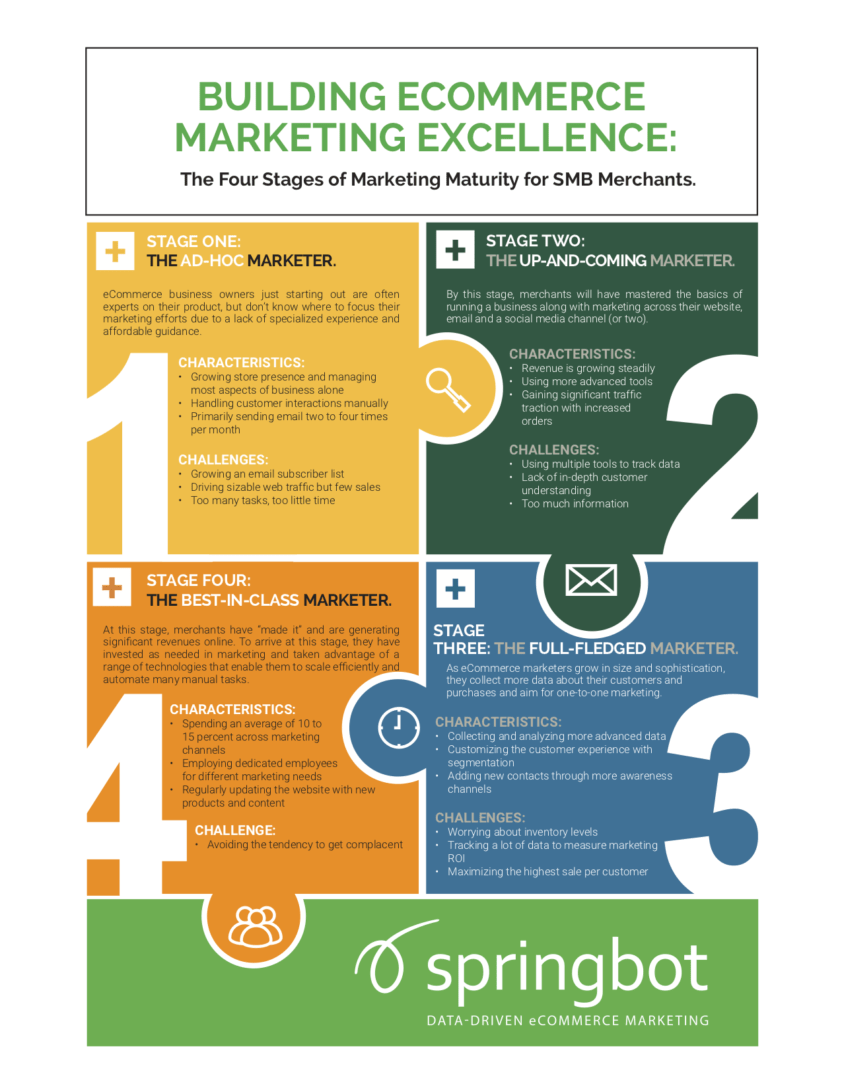How effective is your digital marketing strategy? You may know that it’s making you money, but it could be making you more—much more, in fact. To gain a competitive edge and drive revenue to your online store, your organization needs to be on the path to reaching its full marketing maturity.
With a marketing maturity model, you can get a better sense of your current marketing performance and identify a framework that will help you fill the gaps in your digital marketing strategy. That way, your digital marketing strategies will work together seamlessly to provide a better experience for your customers.
Ready to see how you measure up? Let’s get started!

Determine Your Brand’s Place on the Maturity Model
Marketing maturity models will vary, but they generally include different milestones that an organization can use to characterize its current digital marketing efforts. These stages will look similar to the following outlined below:
Ad-hoc Marketer: The organization lacks a documented digital marketing strategy and has a disorganized data system. Teams work in silos, causing inefficiency and lack of coordination.
Up-and-Coming Marketer: Leadership has begun to recognize its disjointed structure and is making small improvements to its marketing processes and data systems.
Full-fledged Marketer: The organization has an effective digital marketing strategy and is now looking to improve upon it by investing in better tools and technology. Teams within the organization (IT, sales, marketing) work well together at this point.
Best-in-Class Marketer: This is the stage that every marketing executive strives to attain. At the advanced stage, organizations know which channels bring them the best ROI and leverage the best talent, data, and technology to achieve full marketing maturity.
According to a TEKsystems survey, less than one-fourth of organizations reach full marketing maturity. By reaching the highest stages, you can gain a competitive edge over others in your industry.
Develop Your Goals
The path to digital marketing maturity becomes much clearer after you know where your organization currently stands. The next step, however, is harder for any company. Developing an effective plan to reach your business goals can be difficult, but it is essential to set your company on the right path.
Seeing where you fall on the marketing maturity model can help you identify some of your organization’s more obvious weaknesses, but you may not get the full picture from this model alone. In this case, knowing where you stack up against your competitors can help fill in the gaps.
With Springbot’s eCommerce Scorecard, you can easily compare your key metrics with peers in your industry. Get your free report here so that you can form a more strategic plan to improve your marketing efforts and reach your goals.
Leverage the Best Tools and Technology
Once you have identified your goals, you can begin taking steps to evolve your marketing maturity and progress to the next stage. To do this, you need to have the right digital marketing tools and technology.
Today, it’s simply impossible to have a fully optimized marketing strategy without a robust marketing automation platform. Modern marketers need to be leveraging big data with automation if they hope to streamline their workflow, convert more customers, and achieve a better return on investment.
Digitally Transform Your eCommerce Business
You are now equipped with the knowledge of where your business stands and have the tools and technology to achieve your marketing goals. The final step is, without a doubt, the hardest, but it also the most satisfying.
Executing your plan to improve your marketing maturity can be frustrating, especially for a large organization. It can also be scary for some senior-level executives. However, even small changes can help your business rise to new levels and make a significant impact on your bottom line.
Reaching the optimal stages of the maturity model requires your departments to be fully integrated so that data and technology can be leveraged by all. As a result of this integrated approach, you will be able to maximize the performance of your marketing efforts and put your business on a clear path to success.
Conclusion
In the world of digital marketing, change is quick and constant. To become a key leader in your industry, your eCommerce brand needs to have a holistic marketing strategy that is fully optimized and integrated.
By using a marketing maturity model, you can see where your business currently stands and how to improve. That way, you can move your business forward and create a more seamless experience for your customers.
Which digital marketing strategies have been most effective in helping your organization achieve marketing maturity? Share your thoughts with us on Twitter or Facebook!




